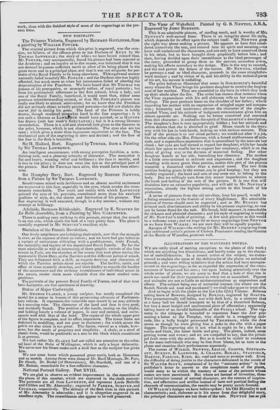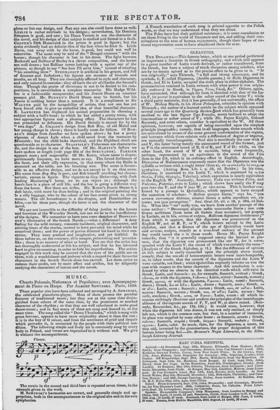ILLUSTRATIONS OF THE WAVERLEY NOVELS.
WE are really tired of making exceptions to the plates of this work ; which are anything but illustration; and hardly come up to the charac- ter of embellishments. In a recent notice of the subject, we endea- voured to explain the cause of the deficiencies of the plates on technical grounds ; and were willing to believe that the artists had been misrepre- sented in the engravings as far as regarded the expression of the coun- tenances of heroes and heroines; but upon looking attentively over the whole series of plates, we are sorry to find that a hole of that size is much too small for their reputations to creep out at unscathed. Figures and attitudes are not so liable to misinterpretations as expressions and effects. The subject being one of universal interest (for where are the Scotch Novels not read and purchased ?) we shall take space to treat of in And to begin with the plates to the last (the 17th) Volume. Rebecca taking leave of Rowena, designed by BOXALL, engraved by GasarEs. Two preternaturally tall ladies, one with dark hair, in a costume that at a fancy ball we should interpret to be that of a theatrical Rebecca, her face a most insipid and sentimental piece of affectation ; apparently taking leave of an invalid fashionable of the FUSELI school. The vig. nette in the titlepage is intended to represent Isaac the Jew pre- senting a letter to the Templar, who stands in a swaggering atti- tude, like a bully knight personated by TuompsoN, while the Jew seems as though he were giving him a poke in the ribs with a paper dagger. The engraving also is not what it ought to be ; the first is coarse and black, the latter feeble and grey. The plates, indeed, seem getting worse and worse; and we are compelled to say, that the princi. pal fault rests with the artists. But as it would be unfair to condemn in the mass individuals who may be free from blame, let us turn to the plates and examine their performances separately. The names Of 'WILKIE, NEWTON, LESLIE, COOPER, STEPHAN... OFF, BURNET, E. LANDSEER_, A. Crust-oar, BOXALL, STANF/ELD, MARTIN FARRIER, KID, &e. read and Seem to promise well. Even the difficulty of doing justice to the characters delineated in the novels of Sir WALTER SCOTT, complained of by the "eminent artists" in the publisher's letter in answer to the complaints made of the plates, would seem to be within the mastery of some of .the painters whose names are here mentioned. But where art instead of invention, tiles. trical imitation instead of natural character, are the sources of inspira- tion, and affectation and artifice instead of. taste and poetical feeling the channels of communication, the results may be pretty surely foretold. Of WILKIE'S designs we have before spoken : his Old Mortality is not characteristic; and, elaborate as is his scene from that delightful story, the principal characters are not those of the tale. NEWTON has as yet Irus but one design, and aiat any one elie could have done as wells srLE is rather extrinsic in his designs; nevertheless, his Dominie Sampson- is good, and new ; his Diana Vernon is not the character of the novel, and his design of that subject is studied and formal to a fault. COOPER'S Dirk Hatteraick in the prison is good in figure; but the artist evidently had no definite idea of the face when he drew it. Little Davie, run away with by the horse, is good, but could not well be otherwise. The same may be said of the " Dougal creature" with the horses; though his character is lost in his dress. The fight between Bothwell and Balfour of Burley is a clever composition, and the horses are well drawn ; but Balfour seems looking with a squint out of the picture, as though to say" See how I'll serve him," instead of minding "his swashing blow." STEPHANOFF IS artificial in his graces, and full of flounces and furbelows ; his figures are streams of brocade and muslin, an ell long. They are thoroughly affected in style and character, and only natural in costume : they all have the air og Charles the Second's time. Though the praise of cleverness is not to be denied to his corn. positions, he is nevertheless a complete mannerist. His Madge Wild- fire is a fashionable masquerader, and his Jeanie Deans an amateur peasant girl. Mr. BURNET'S David Deans may be Scotch, but his Jeanie is nothing better than a natural. It is a compliment to Sir WALTER paid by the incapability of artists, that not one has yet been found able to give an embodied idea of that beautiful character. E. LANDSEER has displayed his animal propensities in choosing a subject with a bull's head ; to which he has added a pretty scene, with two appropriate figures and a pleasing effect. The characters he has not pretended to delineate. His David GeIatly is atoned for by the twa dogs." A. CHALON'S design from Rob Roy, of old Mabel and her young charge is clever ; there is hardly room for failure. Of Box- ALL'S design from Ivanhoe we have spoken above ; he has a pretty vignette of Annot Lyle when a child saved from the massacre by Monteith: but the child looks theatrical, and the Highland chiefs are questionable as to character. STANFIELD'S Fishermen are characteris- tic, and the design is one of the best. Of Mr. MARTIN'S failure we have spoken at length (vide page 664 of the SPECTATOR). FARRIER appears once; and respectably. Of Mr. KiDD, whose name is dispro- portionately frequent, we have more to say. The forced feebleness of the faces, and their silly expression, in that scene where the Bailie is mounted on the table, are his besetting sins. The scene is favour- able to an effective design, and we do not except to it on that score.
His scene from Roy Roy is poor, and Rob himself anything but charac- s . teristic, except in figure. The vignette to Guy Mannering, with Jock
leading Mannering's horse, we do not object to ; although the hero's face is a piece of still life, and the boy is going a different way from the horse. But these are trifles. Mr. KIDD'S Jeanie Deans is a daft lassie, with more fat than feeling ; and in the original painting she Is a silly baggage, who by the colour of her face seems given to strong waters. The old housekeeper is a she-dragon, and Dumbiedikes an idiot,—so let them pass, though the latter is not the character of the novel.
We are not insensible to the difficulty of doing justice to the heron and heroines of the Waverley Novels, nor can we be to the insufficiency of the designs. We remember to have seen some sketches of Boissmso- roses illustrative of the Scotch Novels ;—what a difference! A deep feeling for the wild scenery, romantic incidents, original characters, and Stirring times of the stories, seemed to have pervaded his mind while he conceived them ; and the power of genius directed his hand in their exe- cution. They were poetical and imaginative, and yet faithful. In these before us, on the contrary, all is meagre, painstaking and 'prentice- like ; there is no mastery of mind or hand. You see that the artist has not thoroughly understood or felt his subject, and that he has laboured hard to give no meaning, in order to hide his imperfections. The artists engaged in this work may be assured that the eyes of the public are on them, with a watchfulness and jealousy which a regard for their favourite characters in the Scotch Novels alone has excited. Let them strive to redeem their credit, not by mere effect and artifice, but by diligently studying the characters of nature and the novels.



























 Previous page
Previous page